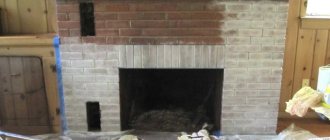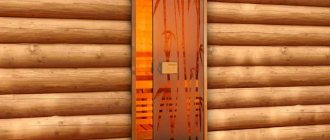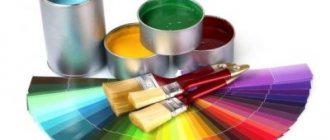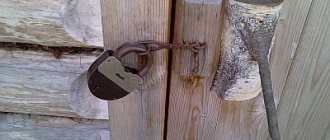It would seem that what could be simpler than painting a door? A flat surface that you just want to roll a roller over. The child seems to be able to cope. What if the canvas is covered with dark varnish? What if a layer of epoxy resin is applied on top?
The door can also be figured or made of wood-based materials of dubious quality. And I want the perfect white color.
So why give up your dream? Of course, there is no need to give up anything. People fly into space, and then there is a door. Of course, you will have to tinker not only with the roller.
Paint for an interior door over varnish
Good day everyone! The apartment has wooden doors of good quality from the previous owners, but they are covered with transparent or yellowish varnish (one, maximum 2 layers).. Now the renovation of 2 rooms + a corridor is being completed and there is no money left for the doors. You could leave it as is, but the color doesn't suit it. Need a dark color. Because I don’t understand paints - a lot of questions arose:
- How to prepare the doors? Do I need to remove the varnish completely (this is very problematic) or just make it matte?
- What grit sandpaper should I use? Or are there varnish removers?
- What paint or dark varnish should I use? (paint must have minimal odor since there is a 5 month old baby at home)?
- Do you need soil or not?
I can only paint with a brush or roller - I have no other options. You need to paint it brown, dark gray, black. It is not necessary that the structure of the tree be visible..
Alexey_oz wrote: should I remove the varnish completely (this is very problematic) or just make it matte?
Not necessarily, for this there are now primers for old paint -,. All these soils are water based.
Alexey_oz wrote: What paint or dark varnish should I use? (paint must have minimal odor since there is a 5 month old baby at home)?
Water-based paint or varnish. Apply everything, for example, with a velor roller. The length of the pile is about 4 mm. If you need to clean up the varnish a little, the sandpaper is 220-240.
The VGT company produces various varnishes and paints, maybe you can choose something from them, consult with consultants. When I painted with matte and glossy paints from various manufacturers, from my little experience I concluded that matte paints have greater coverage than gloss; paint consumption is usually written on the can or on the manufacturer’s website. If the paint appears dry, be sure to add the recommended amount of water, usually up to 5%, sometimes 10-15%. I wish you good luck and success.
Alexey_oz, How did you determine the number of layers of varnish by eye? Renovation in 2 rooms, and the child is 5 months old. It's not the smell that's terrible, it's the dust. If you weren’t afraid of the smell, then any alkyd paint tinted in the color you want would solve the problem. With doors and varnish, you need to understand what kind of varnish it was and how water-based paint will behave on it. Take the ceiling paint and brush the door once from the back end - if the paint has spread and no traces of the brush are visible, then everything is OK. If the paint has dried, but brush marks remain, then the varnish was organic and will either have to be completely sanded off (very labor-intensive) or primed. I can recommend Dulux Super Grip Primer - water-based, does not stink, can be applied to almost anything (any surface that does not absorb water). Paint the top with water-based emulsion tinted in the color you want. Just don’t use matte water-based emulsion - it’s too dirty for a door - dirt will accumulate in the place where you often touch the door with your hand. PS If time is more important, then just paint Dulux Diamond Soft Sheen (aka Diamond Eggshell) - water-based, almost odorless, tinted in any color, can also be used over old oil-based (alkyd) paints, the only drawback is that it’s expensive.
Features of working with different surfaces
If the old door looks good, but the coating has only faded and worn out, then it can be quickly updated by such an event as painting the door without removing the previous layer. The tactics of work will depend on the type of coating available:
Painted doors
This option will cause the least amount of trouble with preparation and has every chance of getting a high-quality surface. To paint interior doors with your own hands, just thoroughly wash the surface of the door to remove dirt and grease stains, and fill all cracks and gaps with putty. It is better to take automotive epoxy paints with a hardener. Such putties do not shrink when dry, and all defects can be repaired in one go.
After the putty has dried, the surface is sanded with fine (120 grit) sandpaper. It is better to use a vibrating sander on large flat surfaces (counters, panels). The main task when working with a painted door is high-quality painting, which is achieved by applying several uniform layers of material. The duration of the work will directly depend on the time it takes for the next painted layer of the door to completely dry.
Old painted door
Lacquered doors
If you decide to renew the varnish surface by applying a new layer, it should be taken into account that all defects will remain visible.
Important! Secondary varnishing rarely gives the expected results. As a rule, the surface should be close to ideal. If you don’t want to tinker with the old coating, then it’s better to paint varnished interior doors that have lost their appearance or coat them with a tinted glaze.
The main difficulty in this situation is selecting putty to match the base material. But the wooden surface is not monochromatic in nature. Even if you spend a lot of time and use several shades of putty, you will still end up with stains on the canvas.
How to paint a lacquered door to transform it
It often happens that you are quite tired of varnished doors, but there is no money to purchase new ones. You can find a way out of this situation, transform the door so that it pleases not only you, but your entire family. But in order to do this correctly, you need to know the technology of preparatory work and the process itself, how to paint a varnished door. In this article we will tell you how to reproduce all these works.
We prepare tools and materials before painting
•Liquid for degreasing.
•Spatula, screwdriver, brush, roller or spray gun.
Preparing the door surface for painting
In order for the paint to adhere well to the surface of the varnished door, it must be pre-treated before painting. Therefore, before painting a varnished door, it should be prepared for this process. You should not skip the preparatory work, since 80% of the successful finishing of the door as a whole will depend on them.
Surface preparation process
•We prepare the place where painting will be carried out. This process can take place on site, then paper or oilcloth is placed under the doors. If you decide to remove the door from its hinges, then prepare a special table on which the doors will be painted.
•All locks, handles and decorative elements are removed, and the surface of the door is degreased with an alcohol or vinegar solution.
•Using a hair dryer, remove the varnish coating from the heated surface of the door with a spatula. This process is carried out until the paint layer is completely removed.
•All surface irregularities and old coating are sanded with sandpaper to a smooth, rough state.
•If there is such a need, then the surface of the door is coated with an antiseptic.
•If there are defects, cracks and chips on the surface of the door, they should be removed using wood putty. The best option for this would be a fine-grained composition that dries quickly.
•After drying, the areas treated with putty must be sanded.
•Then the door leaf is primed in two approaches. After the first layer has dried, the second is applied.
Related article: How to saw a door frame at 90 degrees
Painting a lacquered door
Now we come to the climax of our article, where we will learn how to paint a lacquered door. Work should begin by painting all the recesses and door edging. You need to pay special attention to the joints. Next, the entire surface of the door is painted. You shouldn’t put a lot of paint on the roller to avoid smudges, and if they do happen, you should remove them as quickly as possible before the paint dries. If after the first layer, the door leaf is not uniform and there are bald spots, then you need to apply a second layer of paint.
Painting an old door that has already been painted
It also happens that you have to restore a fairly old door leaf that has already been painted. Here you will have to work a little more. Now we will tell you how to paint a varnished door if it has already been painted previously.
•Locks and handles are removed from the door.
•The door surface is thoroughly washed and dried naturally.
•The door leaf is processed with sandpaper.
•The areas that are not to be painted are sealed with masking tape.
•The surface of the door is treated with a thin layer of primer. You should not apply a lot of impregnation, since it will not be absorbed into an already painted surface, but will stand out as separate puddles on the surface of the door or smudges if the doors are painted in a suspended state.
•After this we proceed to applying the main paint. This should be done after the primer has completely dried. The coating layer should be as thin as possible; it is better to have two or three thin ones than one thick one. Just keep in mind that before applying a fresh coat of paint, the previous one must dry.
Now you know how to paint a lacquered door to breathe a second youth into it. If you follow technology, you can quickly turn an old, boring door into a fresh and attractive one. Now you don’t need to waste money on purchasing a new door; try restoring the old one.
What's the point in updating old doors?
If the doors are outdated or lost their appearance, you can always buy new ones. And given the price level for interior doors, it will not be so expensive. Nevertheless, much can be said in support of restoration:
- Saving. If you choose not the most budget doors, they still cost money. Repairing old interior doors, especially if you do it yourself, will cost much less.
- The value of old doors. It often turns out that old doors have artistic value or are simply treasured as a keepsake. In this case, restoration will be preferable.
- Uniqueness. After personal artistic processing, the doors become a unique product that can become the highlight of the interior.
- Self-realization. For many, working with their hands is a kind of hobby, a hobby that can not only please their family, but also supplement the family budget.
In general, any door can be repaired, with the exception of the cheapest, low-quality ones, and those that are seriously damaged, so much so that they have lost their structural strength. If you have to change not only the covering, but also a significant part of the frame, the game is not worth the candle and it is better to order a new door.
Choosing paint and varnish for interior doors
An old wooden door that has lost its attractiveness can be easily restored by painting. To give the canvas a truly new look, you need to choose the right paint and do the preparatory work. Painting compositions based on aggressive solvents are a thing of the past. An excellent choice for painting a door block is odorless enamel, stain or water-based varnish.
Door painting technologies
The quality of the door coating depends on the tool, application method and professional skills of the craftsman.
Tools
Door painting is done using the following tools:
- Brushes. It is not recommended to paint the entire canvas with just one brush. If you lack experience, the surface will end up with streaks. It will not be possible to apply a thin, even layer of paint with a brush. But without this tool it will not be possible to paint hard-to-reach places, corners, layout patterns or panel margins. Therefore, when painting canvases with a complex configuration, first work with a brush, painting over problem areas.
- Roller. Repainting panel interior doors is done with just a roller. The roller bobbin must be fur, polyamide or polyacrylic. These materials are resistant to most aggressive solvents.
Important! For painting work on door restoration, foam rollers are not used.
Working with a brush
- Compressor (spray gun). A spray bottle will allow you to get an even, thin layer. The result is a perfectly smooth coating. The process of applying paint is much faster than manually.
Related tools you can’t do without:
- gloves;
- paint tray;
- rags;
- masking tape;
- sandpaper;
- putty knife;
- and what you have at your disposal: stools on which you will place the canvas, or sawhorses.
In addition to paint and varnish, prepare putty, primer and solvent.
What to consider when choosing paint?
Having decided to independently restore interior wooden doors, you need to learn an important rule: odorless paint is intended for interior work, and all other enamels and varnishes are for external use.
When choosing enamel for windows and doors, take into account the characteristics of the canvas:
- The door block is made from different types of wood and waste from the woodworking industry. The density of the material determines the amount of paint absorption before it dries. An extra layer is an additional cost. When choosing an expensive paint and varnish material, it is wise to use drying oil. After impregnation, loose wood will be covered with a film, and paint absorption will decrease.
- The consumption of varnish or enamel for doors depends on the surface. For a smooth one, just apply two thin coats of paint. Rough material requires more layers.
- When restoring door blocks, it will not be possible to completely remove the previous coating. The new paint and varnish material should not contain aggressive substances that corrode the old paint. During the reaction, swelling and peeling will appear on the canvas.
Additionally, when choosing a paint and varnish material, the intensity of use of the door block, as well as the level of humidity and ambient temperature
The choice of color is a personal preference. The new canvas looks beautiful under clear varnish or with the addition of stain. After cleaning, it is better to cover the old door with enamel, choosing the desired color.
Frequent changes to the interior are not complete without repainting the door block. To avoid future difficulties, choose a paint material that is easily removed from the surface.
Which paint to choose
First, decide what paints are used to apply to the door:
- Alkyd enamels. This is the most affordable option. Film strength is average. The advantages include a large range of colors and compatibility with MDF, fiberboard and wood. The main disadvantage is the long drying time and the characteristic pungent odor. Among materials of this type there are a large number of glossy coatings.
- Acrylic enamels. This type of paint is a water dispersion of acrylates. The main advantage over other compositions is the absence of odor and quick drying. In addition, the color palette, represented by hundreds of colors, allows you to create unique shades yourself. To protect the surface, it is additionally coated with parquet transparent varnish.
- Oil-based tinting paints are great for transforming interior and entrance doors. Absorbing into the wood texture they give it a unique shade. The only condition for their use is wood, without any coating.
Variety of paints and varnishes
- Nitro enamels. They dry quickly, but at the same time the volatile, caustic solvent evaporates, which can cause poor health and even poisoning. If you take precautions and use personal protective equipment when working, then this option deserves attention. After the solvent has completely evaporated, the coating becomes safe. It is considered a high-quality and fast method of painting.
- Colored varnishes, glazes. These materials are used for painting varnished door panels. Used in cases where there are no significant cracks or chips on the base. To fully restore the varnished surface, the old varnish must be removed, or you can refuse to re-varnish and paint over the interior doors after puttying.
How to treat a wooden door?
Wood has a big disadvantage - it absorbs moisture. An expanded sash cannot be closed or opened normally. To prevent a wooden door from swelling from dampness, before painting it must be treated with a protective impregnation and preparatory measures must be carried out.
- The process begins with removing the sash from its hinges and dismantling the protruding fittings. The canvas is laid on a horizontal surface, sanded and thoroughly cleaned from dust.
- When using paint, the clean surface of the wooden door is impregnated primer. The first layer is allowed to dry and the second treatment is performed.
- The panel door is painted with a roller, and the panel door with a brush. Depending on the structure of the material, 2 to 4 layers of enamel are applied.
- If stain is used instead of paint, the surface of the wooden door is not primed. The door leaf is simply sanded and cleaned of dust. The stain itself is a protective impregnation that penetrates deeply into the wood.
A wooden entrance door needs to be treated especially well, since outdoors the door is constantly exposed to moisture and temperature changes.
Features of door painting
Old doors in apartments and houses were made of solid wood. And therefore, in this article we will pay more attention to the question of how to paint wooden doors. To begin with, it is worth noting that, regardless of the material, there are three stages of painting the door leaf. This:
- Preliminary cleaning of the door leaf. Preparing a door for painting begins precisely with the stage of stripping its surface of the old coating. The quality of the prepared surface will depend on how correctly this process is performed. The cleaned door should be perfectly flat and smooth;
- Primer of the canvas surface. Primed doors for painting will contribute to the correct and uniform distribution of the coloring matter along the plane, and will also ensure a high level of adhesion. Such characteristics determine the quality and durability of the entire door structure;
- Coloring. Painting a wooden door does not differ fundamentally depending on the type of wood. A coloring solution is applied to pre-primed doors for painting. We will look at the technology of painting door structures with a roller below.
Each of these stages influences the achievement of the final result. That is why they should be given individual attention.
Painting a wooden door
How to paint a wooden door?
The paint for the door leaf must meet high performance characteristics and be safe for human health. Conventionally, paint and varnish materials are divided into two groups:
- It is better to paint new wooden interior or entrance doors with transparent The applied layer is a decorative glaze that does not hide surface defects. A transparent coating can highlight the interesting structure of new wood.
- Opaque paints or enamels for windows and doors are made from solvents with added pigments. Under a new layer it is easy to hide wood defects, uncleaned areas of old paint, or simply give the door block a new original look.
Related article: How to open the front door if the lock is broken
Most often, when restoring a wooden door, preference is given to opaque paints.
From a wide variety of interior work, it is best to choose safe water-based paint or varnish. From the street, a wooden canvas can even be coated with nitro paint.
Alkyd paint
It is advisable to use alkyd paint during major renovations when no one lives in the apartment. During this period, all toxic odors will have time to disappear. The dried surface can be matte or glossy, but in any case it repels moisture well.
Alkyd quick-drying enamel is characterized by the presence of a pungent odor. Its popularity is justified by the variety of colors, low cost, and resistance to aggressive environmental influences.
Alkyd varnish
Due to their transparent structure, it is better to cover a new wooden interior or entrance door. The disadvantage is the strong odor and long drying time. A shiny transparent glaze will highlight the beauty of natural wood.
Acrylic paint
The best choice to paint interior wooden doors indoors. The advantage of the coloring composition is the absence of a toxic odor, as well as the ability to preserve the wood texture. A thin layer allows the wood to “breathe”.
Acrylic enamels dry quickly, and after painting there is no toxic odor indoors. Another advantage is the large selection of colors. The disadvantage is the high cost. After drying, the surface becomes matte. Additional opening with acrylic varnish further increases the cost of painting a wooden structure.
Acrylic lacquer
Acrylic varnish is perfect for covering a new, unfinished interior door. The non-flammable composition, harmless to human health, will preserve the color and texture of the wood. The wooden door leaf on the street side is not coated with acrylic varnish.
Thermal enamel
It is unreasonable to use it for an interior door block. The paint is expensive and its main purpose is to protect the painted surface from low and high temperatures. If desired, you can paint a wooden or metal door at the entrance to the house. Thermal enamels differ in their scope of application. For wooden panels, Bosny aerosol paint is suitable, which can withstand, depending on the brand, heating up to a temperature of +200°C or +650°C.
Nitropaint
The most durable and durable paint for wooden doors is nitro varnish or nitro enamel, but it is better not to use it for interior door blocks. They are highly toxic and can only be handled in well-ventilated areas. Nitro paint is suitable for the front door. If it needs to be removed in the future, it will not be easy to do.
Polyurethane paint
Polyurethane paints, characterized by good adhesion to wood, are gaining popularity. With proper preparation of the wooden surface, you can not be afraid of the appearance of blisters on the door. The dried layer of paint is completely harmless to humans, retains its bright color over a long period of use, and is also resistant to scratches. The main advantage of the polyurethane layer is elasticity. If the wood is slightly deformed, cracks will not appear in the paint.
Selection of paint and varnish material
At the same time as preparing the door leaf for painting, take care of purchasing high-quality paint and varnish material. Most old doors were covered with paint, which over time loses its attractive appearance, cracks and peels. Now in the retail trade there is a large number of paint and varnish coatings for wooden doors. And in order to choose a worthy and reliable option, the consumer needs to decide what he wants to see in the end, after the restoration of the door leaf. Some people want to preserve the naturalness of wood, preferring transparent varnishes and paints, while others choose compositions that completely cover the original structure of the door. Based on his preferences, a person can make a choice in favor of:
- Acrylic paints, polyurethane, perchlorovinyl or oil bases, or opaque enamel.
- Stain, varnish, oil impregnation. These compositions will give the wooden base richness and brightness.
- If you want to choose an odorless paint coating for wooden doors, we recommend giving preference to acrylic compositions. When choosing, look at the shade of the dye, keeping in mind that after application to the surface of the wood, the solution will still differ in color.
Experts and craftsmen in this field advise painting wood with acrylic paint. This material is made on a water basis, which allows it to be evenly absorbed and distributed over the entire surface to be painted. In addition, the consistency of acrylic paints allows them to be applied with a regular paint brush without any problems. Painting a wooden door can also be done using other compounds:
- Alkyd paint and varnish solutions. Their main advantage is their high drying speed and excellent water repellency characteristics. Also, such compositions have good resistance to temperature changes.
Apply alkyd paints only to a well-dried surface. If this requirement is neglected, the paint will soon flake off and flake off the wet wooden surface.
- Varnish. Varnishing wooden doors involves choosing the right shade of the solution. It must exactly match the interior design of the room.
Advantages of stain and varnish
For wood, stain and varnish not only give a beautiful appearance, but also additionally protect the natural material from aging. A combined coating of two components is often used. The stain penetrates deep into the wood, where, together with tannins, it forms a protective barrier against moisture and preserves the natural color of the wood from fading. The varnish creates a decorative shine on the door and also additionally protects it from moisture.
Painting schemes
First, a little theory. The interior door can be panel or panel. Depending on this, the execution scheme and the order of staining will depend.
If it is a panel-type canvas, then painting is carried out in 3 stages:
- Coloring begins from the upper corner in the transverse direction. The movement of the brush goes from left to right.
- the second layer of paint is applied in the longitudinal direction.
- the third layer is similar to the first.
Please note that three layers cannot be applied at once; after each coating, time must pass for the composition to dry.
For work, it is better to use a roller, as the brush may leave streaks.
If it is a paneled door, then first all the recesses are painted with a brush, and then the rest of the panel, but with a roller.
Stages of work
All work can be written in the form of the following algorithm:
- It is better to remove the door and twist the fittings. If there is no such possibility (or desire), then handles, hinges, locks and glass are sealed with film and masking tape. It will be difficult to remove the paint. The tape must be removed before the paint dries.
- Washing and drying the door surface.
- Removing peeling areas, filling defects, sanding. Each layer is sanded after complete drying.
- Selecting the type of paint material.
- Applying a primer (paint diluted with the same type of solvent). This will improve adhesion and reduce the likelihood of bleed through putty areas.
- Applying the required number of layers of paint or varnish.
Painting veneered fabric
A wooden door covered with veneer cannot be painted with compounds based on aggressive solvents. First of all, this applies to nitro paint. Due to chemical exposure, matte spots will appear on the veneer. It is better to choose water-based, glyphthalic or polyurethane-based tinted varnishes.
To paint a varnished veneered wooden door, the surface is cleaned using a special floor solution. After removing the old varnish, the veneer is primed, and when dry, it is painted.
It is necessary to renew the entire wooden door block if the coating is damaged over a large area. It is easier to wipe out small scratches by matching the color of paint or varnish.
Material Compatibility
It is not so easy to understand the modern variety of materials. Chemical compositions for the uninitiated person are a secret behind seven locks, and when buying a material to apply to old paint, many rely on luck, hoping that the old layer will not react in any way to contact with the new chemical. There are some recommendations according to which you should select the material depending on what the door is painted with.
Variety of colors
Therefore, before you go for paint, you need to clarify what the canvas is painted with.
- Epoxy and polyurethane compounds contain aggressive solvents. Cyclohexanone or xylene are capable of destroying materials that are reversible polymers obtained by natural curing (nitrocellulose, vinyl, copolymer-vinyl chloride compounds). Simply put, epoxy or polyurethane paint will destroy the coating made with nitro paints.
- Epoxy and polyurethane materials are applied only over the same compositions or primers, maintaining drying intervals for each layer.
- Silicate compounds are generally not applied over any other types of paints.
- Alkyd paints are not aggressive and can be safely applied over any material.
- Copolymer-vinyl chloride compounds and compounds based on chlorine rubber are applied only over acrylic, epoxy, and silicate materials.
Important! To update the door, it is better to use paint of the same type as the previous layer.
Compatibility table
Despite the recommendations of the material compatibility table, it is better to use an experimental test: apply the new material to a small area of the canvas and see the reaction.
How to paint wooden doors
An important condition for quality painting is to prepare the surface well. The wood is treated with an antiseptic against fungi and sanded. Much attention is paid to the coating material: for example, varnish can advantageously present the beautiful texture of the canvas, and paint of a certain shade will help to fit perfectly into the interior design.
How to paint a wooden door with your own hands
To do this, you need to have tools (heat gun, spatulas, sandpaper or grinder, brushes and rollers). The door is prepared for painting: to do this, it is removed and the layer of old coating is removed. The wood is sanded to perfection, and then covered with paint or varnish in several layers and allowed to dry.
How to beautifully paint a wooden door
When painting a door, consider the overall design of the room. Pay key attention to color. For example, light and pastel colors are in fashion now. Such a door is advantageous: it looks beautiful and visually expands the space.
Related article: How an interior door lock works
How to paint wooden doors in a country house
Varnish (matte, glossy, colored) is suitable for this purpose. Keep in mind that the structure of the wood, including its defects, will be visible under the varnish layer. There are many types of impregnations, waxes and varnish-based oils. Before choosing paint for a door, consider its properties.
How to paint old wooden doors
To begin, the door is removed from its hinges. Then it is disassembled, leaving the canvas itself. Old paint or varnish is carefully removed. The wood is covered with the first layer of varnish or paint and left until completely dry. After this, apply a second layer, which must also dry completely. The finished surface is polished.
How to remove old paint from a wooden door
It is best to remove old paint using an industrial hair dryer. You will also need a spatula and fine sandpaper. Warming up the old paint, pry it up with a spatula and remove it. The remaining particles on the wood are rubbed with sandpaper.
You can find out more about how to remove old paint here.
How to paint a solid pine door
The main advantage of pine wood is its texture. Therefore, it is better to coat the door with colorless varnish. The biggest mistake is using regular oil paint. It is also not allowed to apply varnish to wood that has not yet dried.
How to paint a fiberboard door correctly
For a smooth and well-sanded surface, varnish is suitable. Alkyd varnishes are applied without preliminary preparation of the door. If the fiberboard surface has flaws, it is sanded, primed and painted. To add shade, stain is used.
How to paint a varnished wooden door
For this it is better to use varnish, but only with a tint. It is not recommended to use paint over old varnish - it will not stick. Therefore, before painting it is necessary to remove the old varnish coating.
Is it possible to paint veneer doors?
Before painting a veneer door, you need to decide whether to leave the solid color or change the color completely. In the first case, varnish is suitable, in the second - paint. Priming is used if it is decided to coat the veneer with paint. This measure is necessary if the wood has many flaws.
Selection of paints and varnishes
Paintwork materials are classified according to the following criteria:
- By composition (water and organic based);
- By protective effect (against organic and chemical substances, mechanical influences, changes in humidity and temperature);
- By method of use (internal, external, combined);
- By type (impregnations, paints, stains, varnishes).
1. Paints. Can be used to process new and old doors. There are no difficulties in choosing, but due to incompetence people choose the wrong material. Paint and varnish compositions can be transparent or opaque. The first compositions include certain pigments that exhibit the woody structure. But opaque coatings consisting of organic solvents (oil, alkyd and other types) are often used.
The most popular is alkyd enamel, the cost of which is affordable. This coating is highly durable and has a wide range of shades. But the enamel smells bad, its unpleasant odor remains for 2 days, so they work with it outside, first removing the canvas from the hinges or vacating the room. An alternative solution is acrylic enamel, which also has many colors but does not have a toxic odor. Dried paint does not have much strength, so it is additionally treated with acrylic varnish to protect it from mechanical stress.
Rice. 2. Paint on wood
A more durable coating for wood doors is nitro paint, which has optimal strength. The composition is toxic and sometimes leads to allergic reactions, so you need to wear protective equipment when working with it. If an old surface is treated with nitro paint, the panel is prepared and sanded in advance to a light shade.
2. Varnishes. They are traditional coatings that add shine to wood and protect its surface. Typically, varnish is used to coat doors in rooms with high humidity (baths and saunas).
There are many different varnishes:
- Acrylic. The material is resistant to negative influences, humidity and ultraviolet radiation. There are matte and glossy finishes without a toxic odor.
- Nitrocellulose. Wooden doors can be treated with varnish. The coating is not suitable for treating bathrooms and saunas, as it has insufficient strength and cracks quickly.
- Water based varnish. It has no unpleasant odor. Due to different additives, the properties of the material may differ.
- Polyurethane. The varnish has high strength and adhesion to wood, and comes in matte, semi-gloss and glossy. In addition to wood, polyurethane varnishes can be applied to parquet, veneer, and countertops.
- Oil varnish. There is no pungent odor. The composition contains a lot of fatty resins, so the old coating is removed from the door in advance. It is better to apply with a brush due to the thick consistency.
- Polyester. The composition has a pungent odor, is highly durable, but is toxic, so it is suitable for treating street doors.
It is better to paint interior doors with acrylic or polyurethane coating, and resistant materials are suitable for external work or rooms with high humidity.
Rice. 3. Varnish on wood
3. Stains. The purpose of such compositions is to tint the wood and provide temporary protection from negative influences. But it requires constant updating of the layer that emphasizes the wood structure.
There are several options:
- With a varnish base (azure). The composition reduces the duration of work, but aesthetics are difficult to achieve, so a single-color surface can be obtained by spraying with a spray gun;
- With oils. Must be diluted with solvent before use;
- With water. It takes longer to dry, but there is no toxic odor. The composition penetrates deeply, giving a more saturated shade and a clear pattern that looks beautiful;
- Alcohol based. It dries quickly, but is more expensive and has a strong odor.
To protect wood from fungus, moisture and dirt, oil wax is used, which penetrates deeply into the surface. The coating adds strength and shine.
If you are choosing what to stain the surface of the door with, then you need to take into account the drying time and the resulting effect.
How to paint metal doors
Painting metal doors is fundamentally different from painting wooden doors.
How to paint a metal door
The metal surface is cleaned, wiped and dried. At the same time, rust and old coating are removed, and uneven surfaces are primed. Paint for metal doors can be alkyd, graphite, acrylic, hammer, epoxy. It is applied in several layers, after which it is allowed to dry completely.
How to paint a scratched door with spray paint
The damaged area is sanded to prevent rust. Then the area is wiped with solvent. Next, the metal doors are painted with powder paint in several layers, and the first layer can be made with primer.
Recommendations for choosing door colors
The color of the panel is selected based on your wishes. The main recommendations include:
- drying the surface before applying alkyd enamel;
- combination of shade of canvas with furniture;
- choosing a solid wood door coated with oil impregnation for a wooden home;
- combination of an aged door with antique items;
- choosing a dark-tinted door for lacquered furniture;
- use of water-based paints.
During the process of painting a door, you need to follow proper techniques and safety measures.
How to Paint Other Types of Doors
How to paint a laminated door
The first stage is surface preparation. It is cleaned of dirt and unevenness, and then puttied. Then the coating is matted with fine sandpaper and wiped with white spirit. The paint is coated in several layers and waited for it to dry completely.
How to paint a dermantine door
There are special water-based paints for restoring dermantine and leatherette. As an option, you can use a primer with high adhesion, onto which any paint with a high content of plasticizers can be applied.
How to paint a plastic door
For plastic, water-dispersion and acrylic paints are used. The surface is wiped with a special cleaning liquid or hot water to remove dirt. Then the door is treated with fine sandpaper and wiped dry with a napkin. It is best to apply the paint with a spray gun, as it does not leave streaks.
How to stain pressboard doors
The canvas is covered with a layer of stain. Excess of the latter is removed with a rag. The structure of the wood appears through the stain, which is very similar to natural wood. When the stain dries, the door is opened with varnish. In appearance, such a door is no different from the one made from solid wood.
What color to paint the door frames in the kitchen
Designers advise choosing bright, rich colors for the kitchen that give a good mood. Delicate pastel shades and traditional white are also suitable. Contrasting doors look good: the canvas is bright in color and the jambs are neutral, or vice versa.
How to paint interior doors in an interesting way
A safe option is to paint the door moldings in a contrasting color. Geometric compositions made from different colors look original. Stencil patterns, vertical stripes, and circles typical of the pop art style look good. Acrylic, an odorless paint for interior doors, is well suited for this.
How to paint interior doors white
If you don’t know what paint to paint interior doors, choose white - it’s a win-win option. The door is pre-primed and dried. Start painting from the ends or recesses (if there are any). Apply a minimal amount of paint to the brush. The accumulated paint in the corners of the panels is removed with a sponge.
How to paint a door antique
The painting technology is no different from painting a regular door, with the exception of the materials used - stain, patina, special waxes and colorless varnishes. An important condition when painting is that the wood texture should be clearly visible.
So, important conditions when painting a door are careful preparation of its surface and the choice of high-quality paints and varnishes. A bright palette, special aging effects, unusual design solutions - all this will turn the door leaf into a real work of art!
Dyeing technology
If you are painting a new canvas, you should protect it from swelling. First lay it on a flat surface and sand it with sandpaper or a sander. Then the panel is primed, the recesses and smooth areas are processed. After the surface has dried, secondary treatment is carried out.
Rice. 8. Directions for painting the canvas
An old house door needs to be painted with high quality so that there are no stains or smudges on its surface. It is unlikely that you need to buy a spray bottle to paint one or two canvases, so you can use a paneled brush or roller.
After you have chosen what you can use to paint a wooden door, you should familiarize yourself with some of the nuances of the work:
- fluff the brush, removing poorly fixed hairs;
- You need to paint a panel door correctly in 3 stages, using a roller, from the upper left corner you need to move to the right, covering the entire canvas. After drying, the door must be processed in the longitudinal direction. Then you need to paint the canvas from the upper right corner ;
- When processing paneled fabric, you need to use a brush and treat the surface carefully, avoiding excess coating.
Rice. 9. Sequence of web processing
Painting with alkyd enamel
To coat doors with alkyd enamel, the following steps should be followed:
- remove the panel from the hinges so that paint drips do not appear on the surface. Then use a spatula and sandpaper to remove abrasions and the old layer, thoroughly rinse the surface and inspect for defects. Chips and cracks are puttied, the surface is dried and sanded. At the last stage, priming is carried out;
- the finished canvas lies on a horizontal surface of the floor, table or workbench, covered with polyethylene. The existing glass is sealed with tape. For a paneled door, first paint the panels with a brush, and then the protrusions. Subsequently, the entire panel is painted with a roller. With a two-layer application of alkyd enamel, the result will be a consumption of 40-80 g/m2;
- Additionally, you can tint the wenge fabric by impregnating it with a special compound. This paint is based on natural oils. After a layer of paint has been applied, you need to run it over it with a rubber spatula or sponge about 10 times;
- you can take liquid soap with paint. First, the panel is covered with paint and liquid soap. You need to apply another layer of coating to the soap.
Stain treatment
When choosing a stain, no primer is used. The product penetrates into the deep layers of pine or oak wood, coloring its fibers and increasing its protective properties. There are several ways to apply the composition: rubbing, spraying, simple application and staining with a brush. Usually a simple application is used.
Rice. 11. Processing the canvas with stain
Since the stain will adhere better to a damp canvas, it needs to be slightly moistened. First, coloring is carried out along the fibers, and then across them. We perform the next layer in the direction of the fibers. We process the panel with jambs from below so as not to disturb the design of the structure.
After the water-based stain has been applied, the surface should be sanded using sandpaper (due to raised fibers), remove dust and apply the next layer of coating. If an alcohol stain is used, the fibers will not lift and no sanding is required. But aqueous formulations do not have an unpleasant odor or toxicity.
Oil or wax impregnations
There are nuances to processing canvas with oil impregnation. First, the Pinotex composition is mixed well. If applied incorrectly, darkened areas and streaks may appear. For work, use a brush, sprayer, roller or foam sponge. Depending on the porosity of the material, the number of layers will be calculated.
Rice. 12. Application of wax impregnation
First, take a little composition, distributing it evenly across the width of the panel. Then the impregnation is rolled out with a roller or rubbed with a brush without sagging. Drying time is 8-12 hours. No later than a day later, another layer is applied.
Wood imitation
To ensure that you paint interior wood doors with your own hands correctly, follow the instructions:
- apply light paint (beige, white, gray or yellow) to the building material;
- treat the dried surface with liquid soap;
- cover with dark paint, remove liquid soap.
The wood structure can be created on veneered material by treating the fibers with a special brush (an antique effect is obtained). Then you need to apply one or more paint coatings to the surface and sand it.
How to paint laminated doors
Compared to doors made of natural wood, laminated products look aesthetically pleasing, are easy to use and are affordable. To process laminated doors you will need a roller or brush, wood putty with a spatula, sandpaper, rags, solvent and special enamel.
The surface is completely sanded, cleaned of dust with a rag and puttyed with a thin layer. After the putty has dried, it is treated with sandpaper, applied a second time and sanded again after drying. Before painting, the composition is diluted with a solvent. The paint is applied carefully, paying attention to hard-to-reach areas. After 3 layers, the result is secured with varnish.
Rice. 13. Varnishing wood surface
If there are no defects, the laminated coating can be renewed. A tinted varnish or stain is suitable, which is applied after sanding and tinting.











